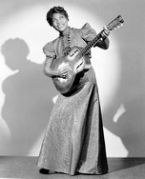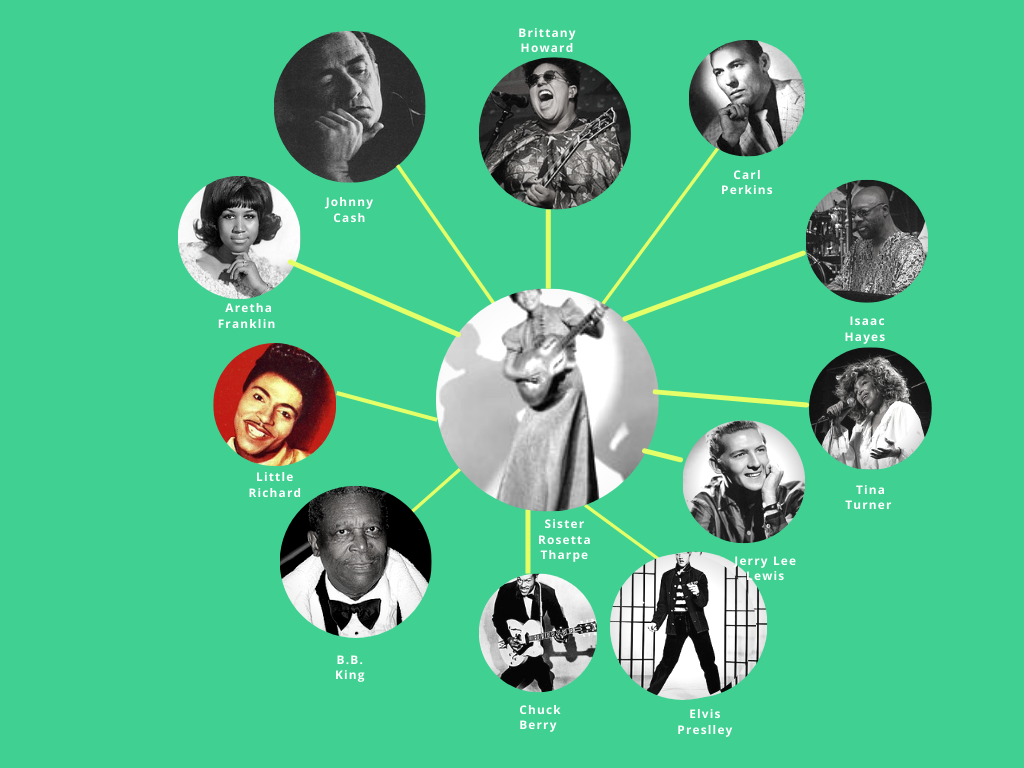
Oh, we hear church people say
They are in this holy way
There are strange things happening everyday
On that last great judgment day
When they drive them all away
There are strange things happening everyday…
Ask anyone about the early pioneers of rock and roll and you will get the usual answers – Elvis, Little Richard, Jerry Lee Lewis, Chuck Berry – but what if I told you that the earliest, and perhaps first pioneer of rock and roll guitar riffs was a woman playing in a traveling evangelical troupe?
Let me introduce you to Sister Rosetta Tharpe.
Born Rosetta Nubin in 1915 in Cotton Plant, Arkansas, Rosetta Tharpe showed at an early age that she was a musical prodigy and by the age of 6 was traveling with her mother as a regular performer as part of an evangelical troupe. For the next two decades she traveled primarily the south performing at church conventions. Sometimes these performances would be broadcast on the radio. Listening one Saturday night in Mississippi was a young man named B.B. King. B.B. would later say that the first time he ever heard an electric guitar it was being played by Sister Rosetta Tharpe on the radio.
Tharpe exploded in popularity in the late 30’s when Decca Records released 4 gospel songs recorded by Tharpe, including the song ‘Rock Me’. Music critic Maurie Orodenker wrote “It’s Sister Rosetta Tharpe for the rock & roll spiritual singing”.
Around this time Tharpe had started performing with bands in clubs and concert halls, which caused her to fall out of favor with a large part of the evangelical community. Evangelicals tended to frown upon frequenting such dens of sin. One of the hallmarks of rock and roll has always been rebellion and going against norms, and Tharpe fully embraced that when in 1944 she recorded what many now refer to as the earliest rock and roll song ever, “Strange Things Happening Everyday”. This song was the first ‘gospel’ song to crossover, hitting number 2 on Billboards ‘race records’ chart, the term then used for what became the R&B chart.
Listen to her guitar at the beginning and you can hear the style that would go on to shape rock and roll.
Tharpe’s guitar style blended urban blues, traditional folk arrangements, and for the final kick she threw in a pulsating swing that caught the ear of the early rock and rollers. In 1947 she was playing a concert in Macon, Georgia and invited a local performer on stage by the name of Richard Penniman. This was his first public appearance outside of a church. A few short years later Richard Penniman, now going by the name Little Richard, would pattern his stage act after Tharpe’s, incorporating the same stomping and shouting that he had witnessed firsthand.

Chuck Berry once said that his career was one long Rosetta Tharpe impersonation. I’ve included a video at the end of this blog that is a compilation of her guitar solos captured on film. I encourage you to watch it to get a feel for how she played – the stage presence that she had, the flamboyance, and the runs that she did up and down the neck of the guitar. Unheard of before her, and often imitated after.
The list of artists that have acknowledged Sister Rosetta Tharpe as an influence is as impressive as it is long (year listed is year inducted into the Rock and Roll Hall of Fame):
Little Richard (1986)
Elvis Presley (1986)
Carl Perkins (1987)
Chuck Berry (1986)
B.B. King (1987)
Aretha Franklin (1987)
Jerry Lee Lewis (1986)
Tina Turner (1991)
Johnny Cash (1992)
Isaac Hayes (2002)
So why is so little known about Sister Rosetta Tharpe? And why has it taken so long for her to be recognized for her contributions? Johnny Cash even mentioned her in his induction speech into the Rock and Roll Hall of Fame.
Tharpe’s career fizzled during the 50’s as rock and roll emerged, dominated by male performers. She had a bit of a resurgence in the 60’s when she toured England with the great bluesman Muddy Waters, but health problems eventually sidelined her. She had a leg amputated in 1970 due to complications from diabetes, and in 1973, when she was on the verge of recording again, she suffered a stroke and died at the age of 58. She was buried in an unmarked grave in Philadelphia.
The late 90’s saw a brief resurgence in her career, with the United States Post Office even issuing a commemorative stamp. It wasn’t until 2007 that she was formally recognized with an induction into the Blues Hall of Fame, yet still no such recognition was coming from the Rock and Roll Hall of Fame. In 2008 a benefit concert was held in Philadelphia to raise money for a marker for her grave, and a headstone was put in place later that year. A Pennsylvania historical marker has since been placed at her home in Yorktown.
On December 13, 2017 Sister Rosetta Tharpe was finally inducted into the Rock and Roll Hall of Fame as an Early Influence. Years after all those that she had influenced had been inducted, she finally joined them. One has to wonder why it took so long for the Godmother of Rock and Roll to be inducted. Surely one who influenced so many rock pioneers should have been one of the first inductees.

There are performers today who are giving her the recognition that she deserves. Brittany Howard of the band Alabama Shakes has listed her as a huge influence, and on a recent performance on Saturday Night Live Lizzo’s guitarist Celisse Henderson paid tribute to Sister Rosetta by playing a Gibson SG Custom guitar – Tharpe’s guitar of choice – and having the name ‘Rosetta’ adorned on her guitar strap.
It is fitting that Sister Rosetta Tharpe is finally getting her long-deserved recognition for her impact on rock and roll. It’s hard to disagree with the notion that she and she alone originated the style of guitar playing that ignited the rock and roll era. A ‘patient zero’ perhaps for the rock and roll guitar sound.
While I am happy that she is finally getting her just due, I can’t help but wonder what it must have been like to be in church, listening to her belt out gospel songs while playing an electric guitar. Oh to have been a fly on the wall. Indeed, there are strange things happening everyday.
I hope you enjoyed this week’s Musical Family Tree. Stay tuned next week for another addition. Feel free to leave suggestions for future articles in the comments. Also, you can now subscribe and be the first to know when there is a new post. Until then, follow your passion, stay happy, and be thankful for whatever inspires you.


Wow! Sister Rosetta’s story is delightful and remarkably told!
Very cool indeed! Thank goodness she finally was recognized more widely. It would have been great it it could have been a lot earlier. I’d like to have been another fly on the wall in that church.
Pingback: Big Mama Thornton – Teke's Musings
Pingback: Brittany Howard – Teke's Musings
Pingback: Musical Tree Twenty! – Teke's Musings